Cultivars - A
Cultivars - B
Cultivars - C
Cultivars - D
Cultivars - E
Cultivars - F
Cultivars - G
Cultivars - H
Cultivars - I
Cultivars - J
Cultivars - K
Cultivars - L
Cultivars - M
Cultivars - N
Cultivars - O
Cultivars - P
Cultivars - QR
Cultivars - S
Cultivars - T
Cultivars - UV
Cultivars - W
Cultivars - XYZ
| |
|
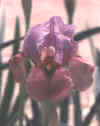 EDITH SELIGMANN (Seligmann, 1985) OGB Bedouin
Woman X Mary of Magdala. Pale lilac standards. Ashes of roses falls. Burgundy
signal and yellow beard. An interesting parent that has produced a wide range of excellent "pinkish"
selfs, pinkish-yellow blends, and smoky tones for me. From its pedigree, it could well be a carrier for tangerine pink.
Crossed onto a pink plicata TB, it gave us JOINT VENTURE – a relatively fertile ¼-bred that is in turn producing a lot of good seedlings. A fully fertile ½-bred I recommend highly for beginners. Named for Col.
Seligmann's late wife, a gracious flower for a gracious lady. After it was registered, we realized that this had originally been one of my crosses – in those days their
were no lines between "yours, mine, and ours" in the seedling patch – but it didn't seem worth the trouble to the record-keepers to file a formal correction. EDITH SELIGMANN (Seligmann, 1985) OGB Bedouin
Woman X Mary of Magdala. Pale lilac standards. Ashes of roses falls. Burgundy
signal and yellow beard. An interesting parent that has produced a wide range of excellent "pinkish"
selfs, pinkish-yellow blends, and smoky tones for me. From its pedigree, it could well be a carrier for tangerine pink.
Crossed onto a pink plicata TB, it gave us JOINT VENTURE – a relatively fertile ¼-bred that is in turn producing a lot of good seedlings. A fully fertile ½-bred I recommend highly for beginners. Named for Col.
Seligmann's late wife, a gracious flower for a gracious lady. After it was registered, we realized that this had originally been one of my crosses – in those days their
were no lines between "yours, mine, and ours" in the seedling patch – but it didn't seem worth the trouble to the record-keepers to file a formal correction.
|
|
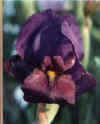 EL CORONEL (Hunt, 1984) OGB Esther the Queen X (Imam Salah x Beisan
Aga). Iridescent purple near-self, with falls slightly redder than the standards. Dark velvety-purple lines radiate from tip of yellow beard. Strong stalk that stands up to the wind and weather. Good for producing deep colors – but the surprises come when it is crossed with lighter lines. Although the ground color is too dark for its own signal to show clearly, it often produces signals on its lighter seedlings. Well worth using in quest of improved signals. Has given some quarterbreds with nice signals
when paired with bicolor TBs. A fully fertile ½-bred I recommend for beginners. I'd wanted to name one of Gene's iris for Gus
Seligmann, because I would not have been able to take care of Gene's selected seedlings without his help. Most of us called him "The Colonel", but that wouldn't have been permissible by AIS rules, so I opted for the Spanish form of "El
Coronel". EL CORONEL (Hunt, 1984) OGB Esther the Queen X (Imam Salah x Beisan
Aga). Iridescent purple near-self, with falls slightly redder than the standards. Dark velvety-purple lines radiate from tip of yellow beard. Strong stalk that stands up to the wind and weather. Good for producing deep colors – but the surprises come when it is crossed with lighter lines. Although the ground color is too dark for its own signal to show clearly, it often produces signals on its lighter seedlings. Well worth using in quest of improved signals. Has given some quarterbreds with nice signals
when paired with bicolor TBs. A fully fertile ½-bred I recommend for beginners. I'd wanted to name one of Gene's iris for Gus
Seligmann, because I would not have been able to take care of Gene's selected seedlings without his help. Most of us called him "The Colonel", but that wouldn't have been permissible by AIS rules, so I opted for the Spanish form of "El
Coronel".
|
|
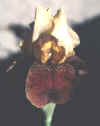 EL GIGANTE (McAllister, R. 1996) OGB- (Desert Princess X Rose of Sharon) X Secret Melody. It's a bilingual play on words. Translation: "The Giant". Pronunciation: el-he-GANT-aye. This iris really named itself because it is both huge and elegant. Standards and style arms are soft gold, its golden falls have such an intense wash of reddish-violet over the blade that they look almost solid reddish-brown except for a fine gold edge and brown-on-gold veining around a brownish-violet-tipped-soft-gold beard. I have high hopes for it with tetraploid arils, but no seedlings so far. EL GIGANTE (McAllister, R. 1996) OGB- (Desert Princess X Rose of Sharon) X Secret Melody. It's a bilingual play on words. Translation: "The Giant". Pronunciation: el-he-GANT-aye. This iris really named itself because it is both huge and elegant. Standards and style arms are soft gold, its golden falls have such an intense wash of reddish-violet over the blade that they look almost solid reddish-brown except for a fine gold edge and brown-on-gold veining around a brownish-violet-tipped-soft-gold beard. I have high hopes for it with tetraploid arils, but no seedlings so far.
|
|
ELMOHR (Loomis, 1942). OB- Austin described it as Bishop's Purple, but it appears more reddish-purple to me. William Mohr X red seedling. |
|
ENGLISH EYES (Wilson, 1996). OGB S glistening white, bright patent yellow midrib sheen blending to soft yellow veining, form globular; style arms deep yellow, large; F soft chartreuse yellow, signal red brown, red brown dots sprinkled around yellow beard tipped orange, recurved form; slight sweet fragrance. Listed in the Beautiful View Iris Garden's 1999 online catalog. |
|
 ENGRAVED INVITATION (McAllister, 1993) OGB+ A
four-color
"plicata" with violet markings on white standards and rust markings on yellow falls. A sib to DELICATE EMBROIDERY, from My Joy X (I. calcaria x I. yebrudii
ssp. Edgecombii), this is presumably triploid but it is relatively fertile both ways. I've also been using it in my attempts to transfer
susiana-type veining to halfbreds. Try it with pastel, pseudo-plicata, or veined
half-breds. Many years ago, I'd fallen in love with the quarter-bred, Engraved. Because this was the best
plicata-like pattern I'd seen in my seedling patch, I wanted it to carry the word "Engraved" in its name. Exactly where the name came from, I can't say – I was just playing one of my word-association games – but it seemed appropriate because this is exceptionally fertile for a triploid and is thus an "Invitation" to experimentation. ENGRAVED INVITATION (McAllister, 1993) OGB+ A
four-color
"plicata" with violet markings on white standards and rust markings on yellow falls. A sib to DELICATE EMBROIDERY, from My Joy X (I. calcaria x I. yebrudii
ssp. Edgecombii), this is presumably triploid but it is relatively fertile both ways. I've also been using it in my attempts to transfer
susiana-type veining to halfbreds. Try it with pastel, pseudo-plicata, or veined
half-breds. Many years ago, I'd fallen in love with the quarter-bred, Engraved. Because this was the best
plicata-like pattern I'd seen in my seedling patch, I wanted it to carry the word "Engraved" in its name. Exactly where the name came from, I can't say – I was just playing one of my word-association games – but it seemed appropriate because this is exceptionally fertile for a triploid and is thus an "Invitation" to experimentation.
|
|
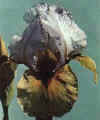 ESTHER, THE QUEEN (Hunt, 1968) OGB
(Ardrun x Ib-mac) X Kalifa Gulnare. Wisteria blue standards. Willow-green falls blended erythrite red. Near-black beard. Blackish-maroon spot. Sometimes considered the "Mother" of modern halfbreds because of its feminine name and reliability as a pod parent, but EQ has also produced a number of registered offspring when used as the pollen parent. Its growth habits were a breakthrough from the predominant type of its time, the
fertile halfbreds that had been produced by line-breeding the C.G. White varieties. Instead of putting out tightly clustered, vertical increase, it puts out daughter rhizomes that spread in a horizontal pattern. If you do much pedigree analysis, you'll quickly notice that EQ's genes have entered the lines of many different hybridizers of
halfbreds. In spite of its age, it remains quite popular with beginners, and I still use it myself with varieties that have outstanding flowers on less-than-desirable plants. I don't know what Gene's specific reasoning was, but if you want to puzzle this out for yourself you'll find the story of Esther (the Jewish maiden who became the Queen of Persia and subsequently saved her people from
anniliation) in the Old Testament Book of Esther. ESTHER, THE QUEEN (Hunt, 1968) OGB
(Ardrun x Ib-mac) X Kalifa Gulnare. Wisteria blue standards. Willow-green falls blended erythrite red. Near-black beard. Blackish-maroon spot. Sometimes considered the "Mother" of modern halfbreds because of its feminine name and reliability as a pod parent, but EQ has also produced a number of registered offspring when used as the pollen parent. Its growth habits were a breakthrough from the predominant type of its time, the
fertile halfbreds that had been produced by line-breeding the C.G. White varieties. Instead of putting out tightly clustered, vertical increase, it puts out daughter rhizomes that spread in a horizontal pattern. If you do much pedigree analysis, you'll quickly notice that EQ's genes have entered the lines of many different hybridizers of
halfbreds. In spite of its age, it remains quite popular with beginners, and I still use it myself with varieties that have outstanding flowers on less-than-desirable plants. I don't know what Gene's specific reasoning was, but if you want to puzzle this out for yourself you'll find the story of Esther (the Jewish maiden who became the Queen of Persia and subsequently saved her people from
anniliation) in the Old Testament Book of Esther.
|
|
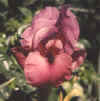 ESTHER'S SON (Hunt, 1972) OGB (Imam Ahmid x Kalifa
Gulnare) X Esther the Queen. Rose standards, darker rose falls. Still one of my favorite breeders in the pinkish lines. Crossed with other pinkish varieties, it has given me tones that range from pinkish ivory through pinkish lavender to deep rose. A fully fertile halfbred that I recommend for beginners interested in working with pinkish or pastel lines. This rather feminine-looking flower, with its rose standards and darker rose falls, bears the masculine designation of "Son" as the result one of
those strange twists of the naming process. Gene had originally planned to name it "Esther's Song" – but, as it turned out, Lin Flanagan had just registered his "Song of Esther". The name "Esther's Song" thus became "Esther's Son". I think it's most appropriate, though, because even though it is fully fertile both ways it has proven to be a much better pollen parent than pod parent. ESTHER'S SON (Hunt, 1972) OGB (Imam Ahmid x Kalifa
Gulnare) X Esther the Queen. Rose standards, darker rose falls. Still one of my favorite breeders in the pinkish lines. Crossed with other pinkish varieties, it has given me tones that range from pinkish ivory through pinkish lavender to deep rose. A fully fertile halfbred that I recommend for beginners interested in working with pinkish or pastel lines. This rather feminine-looking flower, with its rose standards and darker rose falls, bears the masculine designation of "Son" as the result one of
those strange twists of the naming process. Gene had originally planned to name it "Esther's Song" – but, as it turned out, Lin Flanagan had just registered his "Song of Esther". The name "Esther's Song" thus became "Esther's Son". I think it's most appropriate, though, because even though it is fully fertile both ways it has proven to be a much better pollen parent than pod parent.
|
|
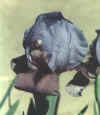 EUGENE A. HUNT (Hunt, 1983) OGB (Oh That Beard X (Card of Thanks x Tuesday Song). Blue-violet standards; dusty red-violet falls. Excellent parent for substance and form, as well as
sunfast, dark flowers. A fully fertile halfbred that has produced some striking seedlings for me. It's a bit slow to increase because it blooms so heavily, so I try to pair it with strong growers. When I visited Gene's garden in 1980, after the Tulsa convention, I saw many impressive seedlings – but this one was my hands-down favorite. With its elegant colors and its handsome bearing and form, it stood "head & shoulders above the rest". Figuratively, of course, as it was also perfectly proportioned. I was able to get several good pictures of it, not just the usual
closeups, but also shots showing the entire labeled clump, and its location within the garden. When I brought his selected seedlings back to New Mexico to handle their registration and introduction after his death in 1981, Gene's family asked that I name one of them for him. To me, this handsome flower was the obvious choice. EUGENE A. HUNT (Hunt, 1983) OGB (Oh That Beard X (Card of Thanks x Tuesday Song). Blue-violet standards; dusty red-violet falls. Excellent parent for substance and form, as well as
sunfast, dark flowers. A fully fertile halfbred that has produced some striking seedlings for me. It's a bit slow to increase because it blooms so heavily, so I try to pair it with strong growers. When I visited Gene's garden in 1980, after the Tulsa convention, I saw many impressive seedlings – but this one was my hands-down favorite. With its elegant colors and its handsome bearing and form, it stood "head & shoulders above the rest". Figuratively, of course, as it was also perfectly proportioned. I was able to get several good pictures of it, not just the usual
closeups, but also shots showing the entire labeled clump, and its location within the garden. When I brought his selected seedlings back to New Mexico to handle their registration and introduction after his death in 1981, Gene's family asked that I name one of them for him. To me, this handsome flower was the obvious choice.
|
|
EVENT HORIZON (Wilson, 1993). OGB S. light mauve, blue-veined slightly darker; F. cream, lightly blended grey mauve, slight brown dotting at hafts; round dark maroon-brown signal; wide yellow beard; slight sweet fragrance. Syrian Moon X Onlooker. |
|
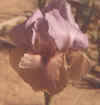 EXPERT ADVICE (McAllister, 1985) OGB Esther the
Queen X Sheik. Pinkish-lavender standards; buff falls, flushed pink on opening. Nice rounded form. A fully fertile halfbred that I recommend for beginners. I made the original cross at the suggestion of the late Gene Hunt, in quest of pink, and found it to be a good parent for pastels. I later found it also to be a good parent for bright colors, with the right mate. Has the open growth habits of its pod parent, and makes a good
"podder" itself, passing its excellent growth habits on to its offspring. I started out making a lot of experimental crosses, just learning through exploration. My goal was gathering information, not introducing anything – until Gene Hunt offered the rather wry remark that I might want to try some crosses that would not only give me the answers I wanted but also produce some worthwhile things. "Any suggestions?" Yes, and this cross (Esther, the Queen X Sheik) was one of them. I fell for the flower myself, but thought I might just be blinded by a mother's pride until Gene gave me his evaluation: "With that color and form [pinkish-lavender standards; buff falls flushed pink on opening; nicely rounded] why, oh why, don't you introduce it?" So I named it to honor both the "Expert Advice" that led to the cross itself and that which led to its final selection. EXPERT ADVICE (McAllister, 1985) OGB Esther the
Queen X Sheik. Pinkish-lavender standards; buff falls, flushed pink on opening. Nice rounded form. A fully fertile halfbred that I recommend for beginners. I made the original cross at the suggestion of the late Gene Hunt, in quest of pink, and found it to be a good parent for pastels. I later found it also to be a good parent for bright colors, with the right mate. Has the open growth habits of its pod parent, and makes a good
"podder" itself, passing its excellent growth habits on to its offspring. I started out making a lot of experimental crosses, just learning through exploration. My goal was gathering information, not introducing anything – until Gene Hunt offered the rather wry remark that I might want to try some crosses that would not only give me the answers I wanted but also produce some worthwhile things. "Any suggestions?" Yes, and this cross (Esther, the Queen X Sheik) was one of them. I fell for the flower myself, but thought I might just be blinded by a mother's pride until Gene gave me his evaluation: "With that color and form [pinkish-lavender standards; buff falls flushed pink on opening; nicely rounded] why, oh why, don't you introduce it?" So I named it to honor both the "Expert Advice" that led to the cross itself and that which led to its final selection.
|
|